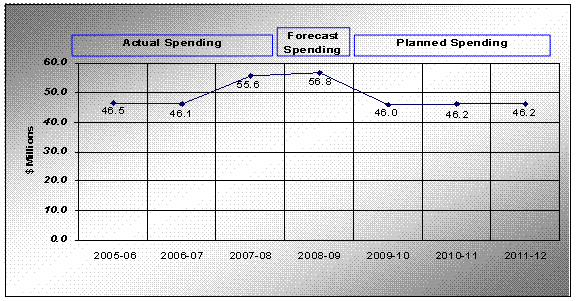Common menu bar links
Breadcrumb Trail
ARCHIVED - Canadian Radio-television and Telecommunications Commission
 This page has been archived.
This page has been archived.
Archived Content
Information identified as archived on the Web is for reference, research or recordkeeping purposes. It has not been altered or updated after the date of archiving. Web pages that are archived on the Web are not subject to the Government of Canada Web Standards. As per the Communications Policy of the Government of Canada, you can request alternate formats on the "Contact Us" page.
Minister’s Message

The Canadian Heritage portfolio gives Canadians the opportunity to participate in society, to achieve their full potential, and to celebrate their heritage and their culture. As a departmental agency, the Canadian Radio-television and Telecommunications Commission (CRTC) is working to achieve this goal.
The communications industry is an important part of the everyday lives of Canadians. It showcases Canada and the best the world has to offer through diverse programming choices, world-class audiovisual production services, and access to a multitude of distribution platforms. During these uncertain times, the Government of Canada wants to ensure that Canadians continue to enjoy diverse Canadian content choices. We must ensure that our portfolio organizations, such as the CRTC, remain accountable and that taxpayer dollars are well spent. We must all harness the opportunities that new technologies provide to refresh our approach to arts and culture and meet the changing needs of Canadians.
Today’s digital world presents increasingly complex challenges that require creative solutions. In the coming year, the CRTC will explore the opportunities offered by new technologies to broadcast Canadian programming and provide quality telecommunications services. The CRTC also intends to work with the broadcasting industry to prepare for the transition to digital transmission in Canada. It will be important to develop strategies to ensure that all Canadians have access to the conventional broadcasting services they currently enjoy.
As Minister of Canadian Heritage and Official Languages, I invite you to read the Report on Plans and Priorities for 2009–2010 prepared by the CRTC. This report shows the CRTC’s commitment to ensuring that the creativity and innovation of Canadian society contribute not only to our cultural vitality, but also to our future.
The Honourable James Moore
Chairman’s Message

I am pleased to present the Canadian Radio-television and Telecommunications Commission’s (CRTC’s) Report on Plans and Priorities (RPP) for 2009–2010. I would like to highlight four activities that demonstrate how the CRTC will support a strong communications industry.
First, the CRTC will hold public hearings to renew the licences of conventional, specialty and pay television services. This exercise will provide us with an opportunity to discuss many issues with Canada’s broadcasters, including their plans for conventional television’s transition from analog to digital transmission. In setting the terms and conditions
for the new licences, the CRTC will ensure that these services reflect Canada’s cultural diversity and that programming in both official languages is available to all Canadians.
Secondly, we will conclude our proceeding on broadcasting in the new media environment and publish our findings. We held a hearing in February 2009 to gain a better understanding of Canada’s participation in this environment and its impact on the traditional broadcasting system. We are also evaluating whether the CRTC’s current approach, which consists of
exempting new media and mobile broadcasting services from regulation, remains appropriate.
Thirdly, the CRTC will undertake a major proceeding on the Internet traffic management practices that are currently employed in the retail and wholesale markets, as well as those that could be adopted in the future. Canadian Internet service providers use different approaches to manage the traffic on their networks. Our proceeding will address key issues such as the
practices that are acceptable under the Telecommunications Act and the criteria that should be used in the event that specific practices need to be authorized.
Finally, we will ensure telemarketers comply with the National Do Not Call List rules. The list was welcomed by Canadians, who registered nearly five million telephone numbers in the 60 days following its launch on September 30, 2008. This service is designed to help Canadians protect their privacy by reducing the number of unwanted telemarketing calls and faxes they
receive.
I expect that the year ahead will hold many challenges for both the communications industry and the CRTC, particularly as we contend with the evolution of convergence in the midst of economic uncertainty. The CRTC is committed to exercising fiscal prudence in carrying out its mandate. At the same time, we will continue to reduce or remove regulations where possible
and help to resolve competitive disputes as they arise.
Konrad von Finckenstein, Q.C.
Chairman of the Canadian Radio-television and Telecommunications Commission
Section I – Commission Overview
1.1 Summary Information
1.1.1 Raison d’être
The Canadian Radio-television and Telecommunications Commission was established to sustain and promote Canadian culture and achieve key social and economic objectives.
1.1.2 Responsibilities
The CRTC fulfils its mandate by regulating and supervising Canadian broadcasting and telecommunications in the public interest. The CRTC is governed by the Broadcasting Act of 1991 and the Telecommunications Act of 1993.
The Broadcasting Act seeks to ensure, among other things, that Canadians are provided with a predominance of Canadian content and have full access to the broadcasting system, as participants and as audiences.
The Telecommunications Act seeks to ensure, among other things, that increased reliance on market forces for the provision of telecommunications services is fostered, that regulation, where required, is efficient and effective, and that Canadians have access to reliable telephone and telecommunications services at reasonable prices.
The CRTC is an independent public authority and reports to Parliament through the Minister of Canadian Heritage and Official Languages.
The CRTC’s mandate is to serve the public interest by maintaining a balance between the cultural, social and economic goals of the legislation on broadcasting and telecommunications, taking into account the wants and needs of Canadian citizens, industries and various interest groups.
1.1.3 CRTC Strategic Outcome
The CRTC will fulfill its mandate by achieving the following strategic outcome:
| S.O. 1 Canadians have access to a wide variety of high-quality, Canadian-produced programming, and to reliable, affordable and high-quality telecommunication services. |
1.1.4 CRTC Program Activity Architecture

1.2 Planning Summary
1.2.1 Financial Resources
| 2009-2010 | 2010-2011 | 2011-2012 |
|---|---|---|
| 46.0 | 46.2 | 46.2 |
1.2.2 Human Resources
| 2009-10 | 20010-11 | 2011-12 |
|---|---|---|
| 425 | 425 | 425 |
1.2.3 RPP Summary Table
Canadian Broadcasting
| Performance Indicators | Targets |
|---|---|
| 1. Diversity within the broadcasting system is reflected in the ownership of undertakings, the availability of programming genres and the language of broadcast. | Maintain the current levels of diversity as measured in the CRTC Communications Monitoring Report. |
| 2. The number of applications received, the number of proceedings initiated by the CRTC, the number of interventions filed with the Commission and the number of Canadian broadcasting services licensed as a result of the proceedings. | Increase the number of proceedings for new services by 10 per cent. |
| Program Activity | Expected Results | Forecast Spending 2008-09 |
Planned Spending | Alignment to Government of Canada Outcomes | ||
|---|---|---|---|---|---|---|
| 2009-10 | 2010-11 | 2011-12 | ||||
| Canadian Broadcasting |
|
30.3* | 16.7 | 16.7 | 16.7 |
A vibrant Canadian culture and heritage. |
| Total Planned Spending | 30.3 | 16.7 | 16.7 | 16.7 | ||
*Includes allocated costs from Internal Services, temporary funding and operating budget carry forward.
Canadian Telecommunications
| Performance Indicators | Targets |
|---|---|
| 3. The percentage of Canadians who have access to wireline and wireless services, the average percentage increase in Primary Exchange Service rates for a given year and the number of complaints the Commission receives regarding quality-of-service issues. | Ensure that the proposed rates for telephone service and other telecommunications services submitted by the major service providers meet pricing constraints imposed by the Commission, limited to the rate of inflation. Monitor quality-of-service indicators to ensure that the telecommunications service providers deliver high-quality services. Ensure there is no increase in the number of quality-of-service complaints. |
| 4. Various statistics on the telecommunications market, such as wireline telecommunications revenue market share by type of service provider (percent) and total telecommunications revenues by type of service provider (dollars). | The CRTC's target is to remove regulatory obstacles to maximize the reliance on market forces and to foster an efficient and competitive market. The Commission will regulate the industry only in cases where the market fails to fulfill the Telecommunication Act’s objective. Historically, competitor revenue growth has been approximately two per cent per year. The Commission's target is for the continuation of this trend. |
| Program Activity | Expected Results | Forecast Spending 2008-09 |
Planned Spending | Alignment to Government of Canada Outcomes | ||
|---|---|---|---|---|---|---|
| 2009-10 | 2010-11 | 2011-12 | ||||
| Canadian Telecom-munications |
|
26.5* | 13.4 | 13.5 | 13.5 | A fair and competitive marketplace. |
| Total Planned Spending | 26.5 | 13.4 | 13.5 | 13.5 | ||
*Includes allocated costs from Internal Services.
Internal Services
| Program Activity | Expected Results | Forecast Spending 2008-09 |
Planned Spending | Alignment to Government of Canada Outcomes | ||
|---|---|---|---|---|---|---|
| 2009-10 | 2010-11 | 2011-12 | ||||
| 2.1 Internal Services1 | Note | 15.9 | 16.0 | 16.0 | No data required for this year. | |
| Total Planned Spending | 15.9 | 16.0 | 16.0 | |||
Note: In 2008-09 Internal Services costs were allocated to Broadcasting and Telecommunications activities.
1.2.4 Contribution of Priorities to Strategic Outcome
The CRTC will achieve its strategic outcome by focusing on operational priorities for its program activities and management priorities.
1.2.4.1 Operational priorities – Canadian Broadcasting
Program Activity: Canadian Broadcasting
| Operational Priorities | Type | Links to Strategic Outcome(s) | Description |
|---|---|---|---|
| Digital transition | Ongoing | SO 1 |
|
| Implementation of the broadcasting distribution undertakings decision | Ongoing | SO 1 |
|
|
New media |
New | SO 1 |
|
| Emerging artists | Ongoing | SO 1 |
|
| Private conventional TV licence renewals |
New | SO 1 |
|
|
CBC/SRC licence renewals |
New | SO 1 |
|
| Social policy direction | New Ongoing |
SO 1 |
|
|
Convergence policy |
Ongoing | SO 1 |
|
1.2.4.2 Operational priorities – Canadian Telecommunications
Program Activity: Canadian Telecommunications
| Management Priorities | Type | Links to Strategic Outcome(s) | Description |
|---|---|---|---|
| National DNCL | Ongoing | SO 1 |
|
| Wireless 911 | New | SO 1 |
|
| Revisions to wholesale services rates and terms | Ongoing | SO 1 |
|
| A focused and modernized regulatory framework | Ongoing | SO 1 |
|
| Streamlining tariff approval and other processes | Ongoing | SO 1 |
|
|
Traffic management practices |
Ongoing | SO 1 |
|
| Mediation | Ongoing | SO 1 |
|
| Industry analysis | Ongoing | SO 1 |
|
| International Outreach | Ongoing | SO 1 |
|
1.2.4.3 Management priorities
Background
To help determine how it should evolve in the current era of convergence, the CRTC initiated a strategic exercise in 2007. The product of this exercise was the Future Direction initiative, whose scope extended not only to the entire Commission, but also to its stakeholders. The initiative established a new strategic intent for the CRTC: to foster a globally advanced, market-driven
communications system that benefits all Canadians. It also better positions the Commission to deliver on three core business objectives: a strong Canadian presence on all platforms, healthy and competitive communications markets, and consumer accessibility and participation. Finally, three priority areas were identified for 2009–2010, which are presented in the following
table.
| Operational Priorities | Type | Links to Strategic Outcome(s) | Description |
|---|---|---|---|
| A more focused regulatory approach | New | SO 1 |
|
| Greater outreach to citizens and stakeholders | New | SO 1 |
|
| An improved organization | Ongoing | SO 1 |
|
1.2.5 Risk Analysis
Operating environment
The communications industry has changed profoundly in recent years. New digital technologies have transformed how Canadians communicate, do business and inform and entertain themselves. As the broadcasting and telecommunications industries embrace new technologies and move toward convergence, they demand lighter regulations, faster processes and better service standards from the CRTC. At the same time, the Government of Canada has issued a policy that accelerates the deregulation of the Canadian telecommunications industry and increasingly emphasizes market forces.
Risks
- The current global economic uncertainty and its effects on the industry may:
- produce financial concerns and takeovers
- create difficulty for industry players in meeting certain regulatory obligations
- affect the rollout of competition, and
- cause an increase in the number of applications received by the CRTC, for example to amend licensing conditions, modify tariffs or effect a change in ownership.
Challenges
- The ever-changing technological and economic environment is a significant challenge for the CRTC. The Commission must keep pace with change and adjust the timing of its proceedings.
- The CRTC must manage its service delivery functions and increasing workload with a reduced budget.
- The CRTC expects that further dependence on market forces in telecommunications markets will increase the number of competitive disputes. The Commission will be called upon to resolve these disputes efficiently and effectively.
- Nearly 30 per cent of the CRTC’s workforce is eligible to retire in the next five years.
- The lack of Administrative Monetary Penalties in the Broadcasting and Telecommunications Acts limits the CRTC’s ability to ensure compliance with its regulation.
Opportunities
- The evolving world of communications is a source of opportunities for Canadian voices in the broadcasting system.
- With innovation comes increased choice and a more flexible and accessible system.
- The Canadian communications sector’s evolution presents an opportunity to promote the development of high-quality Canadian communications content and infrastructure.
1.2.6 Expenditure Profile
For the 2009–2010 fiscal year, the CRTC plans to spend $46 million to meet the expected results of its program activities and contribute to its strategic outcome. This amount represents a decrease of approximately 19 per cent, or $10.8 million, compared to the 2008–2009 fiscal year. This change is primarily attributable to the end of temporary funding that the
Commission received during the two previous fiscal years.
When compared to previous years, the total spending for fiscal years 2007–2008 (actual) and 2008–2009 (forecast) increased. The Commission received temporary funding to address an increased workload related to its legislative and regulatory responsibilities. The amounts for these years also include authorized operating budget carry-forward amounts and applicable Treasury
Board vote transfers.
Details on the approved increases and the related billing impact for broadcasting and telecommunication industries are noted in Broadcasting Circular CRTC 2007-9 and Telecom Circular CRTC 2007-18 dated December 21, 2007. More information about these decisions is available online at the following address: http://www.crtc.gc.ca/eng/archive/2007/c2007-9.htm
The figure below illustrates the CRTC’s spending trend from 2005–2006 to 2011–2012.

For the 2005–2006 to 2007–2008 periods, the total-spending figures include all Parliamentary appropriation and revenue sources, including: Main Estimates, Supplementary Estimates, Treasury Board vote transfers and revenues from Part I broadcasting licence fees and telecommunications fees. The figures also include operating-budget carry-forward adjustments.
For fiscal years 2009–2010 to 2011–2012, the total-spending figures correspond to the planned vote-netted revenues2. Supplementary funding and carry-forward adjustments are unknown and therefore not reflected.
1.2.7 Voted and statutory items displayed in the Main Estimates
| Vote # or Statutory Item (S) | Truncated Vote or Statutory Wording | 2009-10 Main Estimates |
2008-09 Main Estimates |
|---|---|---|---|
| 45 | Program expenditures | - | - |
| (S) | Contributions to employee benefit plans | 5.4 | 5.5 |
| Total | 5.4 | 5.5 | |

